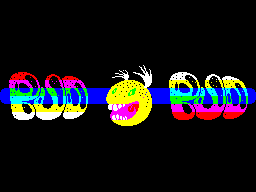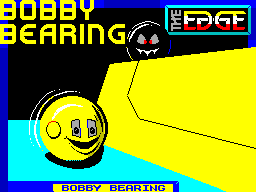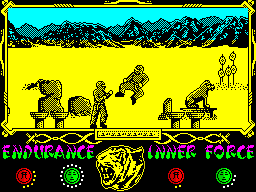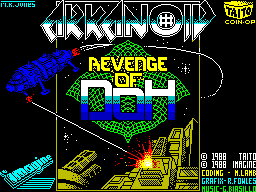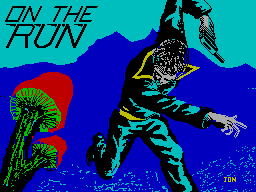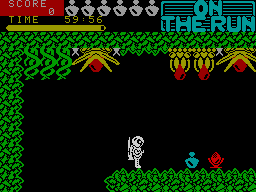Jim Bagley worked on Spectrum Games for companies such as Ocean Software, US Gold and Melbourne House during the late 1980's and early 1990's.
Some of his games include the excellent conversions of classic arcade games Cabal and Midnight Resistance, playable movie tie-in Hudson Hawk, graphical adventure Throne of Fire and the seminal golfing simulation classic, World Class Leaderboard.

Jim was more than happy to take us through his days of coding on the ZX Spectrum, his thoughts on current games and his views on the booming retro gaming scene.
1: What was the first computer you ever programmed on? And how old were you at the time?
The first computer I ever programmed was a Sharp MZ80K. When I went to high school at 12 years old they had about 6 Sharp MZ80Ks, 1 BBC Model B and a research machines RM 380Z :)
In the dinner time break and after school, everyone was around the BBC playing classic games like Pacman, Chuckie Egg and Defender etc, so I decided to have a play on the MZ80Ks as they were always easy to get access to lol. They also had a basic programming book that the school had with the Sharps, I used to type out the programs in the book, so I could see how it worked, changing things here and there, to see what affect it had on the program.
At the time, the computer teacher was a converted maths teacher, ie, they probably said you know maths, you can teach computers to the kids lol, but I was teaching myself faster than he was able to teach himself to teach the kids :) guess I was a natural to it, more so than he was at least lol. I then started to create my own basic programs, like the scrolling road driving type games. I obviously would still queue up to play games on the BBC, after all this was why I liked programming the Sharps, so I could learn how to program my own games.
http://www.oldcomputers.com/museum/photos/Sharp_MZ80K_System_1.jpg
http://www.oldcomputers.com/museum/photos/Acorn_BBCb_System_s1.jpg
http://www.old-computers.com/museum/photos/ResearchMachines_RM380Z_System_1.jpg
2: How did you get into developing games? Did it start with BASIC programming before you moved into assembler?
I got into developing games by writing in basic back on the MZ80Ks, then my mum realised my thirst for knowledge of computers and got a loan to buy me a ZX81+16KB ram-pack.
I was writing more and more games (still in basic) then our school got about 10 BBC model Bs in, so I did Sinclair ZX81 basic at home, and BBC basic in school break times. They also got a machine code tutorial package for the BBC, which was very well and very simply done.
You had 256 boxes 16x16 and each box could have an instruction in, or data, you could then enter your data into each box, then run it, this was brilliant, as I could now teach myself simple assembly programming, or more importantly, what the instructions actually do.
I then started to write little assembly routines on the BBC, as BBC basic had a built in assembler :D
I then ended up writing a 3-channel music player, then I learnt about interrupts, and had it playing under interrupts :D Anyway, by this time my mum had upgraded me to a spectrum 48K and the world was now my oyster. Not only did I have colour, but I had 48KB - that was loads of memory back then lol, and now that I knew 6502.
It was only a matter of time to teach myself Z80 thanks to the Spectrum manual having the instruction set (plus more importantly the byte values for each instruction) in it, I could now type that into a data statement, and poke it into ram, and call it from basic.
I started out with a beep sound, and explosion sound in assembly, then I moved onto drawing things onto the screen, ie maps and sprites. By this time I was 16 and it was time to leave school and head out into the big world, so I headed to my favourite computer game shop, MicroByte in Liscard Village, (where I spent a lot of my weekends while at school looking at and buying games when I could).
I guess I was a regular lol, and therefore when it came time to leave school, I asked them if there was any local games companies, and if any of them came into the shop, or they had details of - and to my surprise there was (quite a few I found out later lol) but for now Consult Computer Systems was local and came into the shop often, so he got their details, and I got an interview, and that's where I started into the games industry.
3: You seemed to start Spectrum game development at the crest of the 'boom' years of the mid-eighties with games such as Throne of Fire in 1987. How was it working with 8-bits on into the early 90's as the 16-bit machines really took hold of the home market?
Yes, I started at the crest of the 'boom' years in the mid-eighties, starting with Throne of Fire.
I loved working on the 8-bits, it was just you and your abilities to get what you needed to draw on screen fast enough, thinking about how you did things, and what optimisations you could do.
Yes, it would have been nice to have a fast 16-bit processor, and LOADS of memory in comparison to 48KB, but I loved and still do love the spectrum, it's where I got started in the games industry.
I have so many many memories of playing and making Spectrum games - even to the point of doing remakes of some Spectrum games recently, as you can probably guess I'm a big retro computer game fan also.
I did however eventually get myself an ST to play on, and learn to code as at work, we already had ST and Amiga coders, and since we were a small company, doing one game on many platforms, I didn't need to code the ST officially, except to do the map making tools for the Spectrum and Amstrad and C64 etc games.
4: What did you like about developing on the Spectrum?
What I loved about developing on the Spectrum (which may sound strange) was the fact that it didn't have hardware sprites, it was just down to you and your creative thinking to get as close to an arcade game as possible on a Spectrum.
I loved the challenge I guess, dating back to when I started teaching myself, learning new ways of doing things, tweaking and changing things. Also I made myself start each new game I wrote from scratch, so that I wasn't getting held back by legacy code, nor was I having to spoon each new game into the way an older one was written, which also meant each game could advance from the last, with better ways of doing things that I'd maybe thought of after making the previous one.
A lot of the retro games I make now in what little spare time I have are based on a Spectrum display, and done on a microcontroller called the propeller from parallax.
5: Conversely, what did you not like about programming the Spectrum?
The only thing about the Spectrum, was it didn't have a SID chip lol, that just sounded and still does sound fantastic even to this date. I know a few people who have emulated the SID chip on a microcontroller, and I use their emulated SID chip in some of the retro games I make.
6: Did you work on any of the other 8-bit or 16-bit machines during the 80's and 90's? If so - was any particular machine easier to develop on?
During the 80's and 90's I worked on lots of computers.
I got myself a C64 so I could learn how to code that too, (not that I needed to as we had C64 coders) but because I wanted to know how to code on the C64s, especially since I knew 6502.
I also got a CPC6128, and then got collared into doing Spectrum and Amstrad versions of the games I wrote, since a lot of the CPC games used the same spectrum graphics, and a lot of the same game logic code as the Spectrum version.
As I stated earlier, I also got an ST to teach myself, and ended up using that to create tools for map editors etc.
I did like the ST more than the Amiga, yes, the Amiga looked better, and had better games because of the stupid way the ST screens video RAM was laid out in bitplanes, but like the Spectrum the ST didn't have any sprites hardware. It all had to be done in software, so I think because of this, it's why I prefered the ST to the Amiga, because you don't get time to be a lazy coder, since you have all the hardware do everything for you.
You had to think about how exactly you were going to get your sprites to screen, or how you were going to scroll it etc, and yes, it was much easier to code on the ST, and Amiga for that matter, because of the fact you had a floppy drive, (or later hard drive) which meant you didn't have to wait til you'd loaded the assembler etc, then loaded the files for where you were up to.
Floppy drives were great for speed, especially compared to tape drive, and the not so reliable Spectrum microdrive lol
7: Were you given 'free reign' to develop games, or did other people come up with gaming and coding ideas too?
Unfortunately I wasn't given free reign, as, as I was finished the game I was doing they were already sorting out organising the next game for me to do.
This was a shame, because when I was doing hudson hawk, on the original GameBoy (IIRC) I also wrote a space invaders clone, and said could we do this in a game pack, with space invaders and scramble etc, but my boss at the time (Paul Finnegan) said no.
A few months later, Space Invaders came out for the GameBoy and was #1 in the GB charts for about 12 weeks, which I wasn't overly happy about :( as that could have been my game!
(That must have been frustrating)
8: Which other games developers or software houses impressed you at the time?
In the days of the Spectrum, Joffa Smiff, and Matthew Smith were both legends, and I thankfully got the chance to work with Joffa for a good many years.
I also met Matthew a couple of times through another work mate, called Peter Leyland, who knew him, oh and of course in the early 90's there was ID and Wolfenstein, oh, and before that, I must add Malcolm Evans.
I have paid retro homage to all these guys by doing remakes of their work, on the microcontroller I told you about earlier, the Propeller.
I've done 3D Monster Maze, and Manic Miner, and even A Wolfenstein ray casting demo with textures :D and Joffa's mag game Hyper-Active clone was done on GBA many moons ago.
9: Do you have any favourite Spectrum games (your own titles and games by other coders or software houses)?
My favourite Speccy games, (yes games, there are a few! lol), with mine first for biased reasons lol Cabal and Midnight Resistance.
I also loved... Bruce Lee, Manic Miner, Jet Pac, Hyper-Active, 3D DeathChase, ZZoom (don't ask why, but there was something gratifying about mowing down the little men :D muwhahahaaaaa lol ) - (Yes, there was!), Head Over Heels.
10: Do you currently develop games software on modern consoles or PC?
I am currently developing a game at work for the PS3/Xbox360/PC, but also in what little spare time I have developing freeware games for my Propeller based retro style console :)
11: How do you think todays games compare to those from the 8-bit era?
Some of todays games seem sparce in comparison, there was always some sort of peril on screen all the time, nowadays you have to go find it, there are the odd title which keep spawning baddies close, but not many, I guess thats why I still enjoy the retro classics :)
12: What was development like during your time at Ocean and Special FX?
During the Ocean/Special FX years, it was great in the fact that we got some great games to convert, like Cabal and Midnight Resistance, but we also got some bad film conversions to do, like Hudson Hawk, which not only was it a flop in the movies, but Bruce Willis didn't want us to have his face on the sprite, as it supposedly couldn't do him justice lol.
It's a shame the film was such a flop, as I quite liked playing the game on the GameBoy :)
13: The retro gaming scene is really growing. Any chance you could assemble another game on the Speccy? - I'm sure it would be met with a lot of enthusiasm!
Yes, the retro scene is growing, and I've been enjoying it for years lol :D
Doing a game on the Spectrum? hmmmmmmmm, there's a posibility, but I'm no good at art, so we'll have to see, maybe I could do a puzzle game, those graphics are easy enough for me to do :D
14: Can you tell us some of the classic games you have re-written?
I've remade Bruce Lee for GP2X and GBA (both freeware), and for my propeller Hybrid board.
I've done 3D Monster Maze, Manic Miner, Jet Pac, Frogger, Scramble, Dragon's Lair, Head Over Heels (still making, there's lots of rooms), Atari 2600 HERO (still making - again lots of rooms), A Wolfenstein 3D Textured maze demo - and many other games.

Once again many thanks to Jim for taking the time to talk to us. We will be checking back at Jim Bagley's Game Site to see how Head over Heels and HERO are coming along!
Arcade Games, ZX Spectrum Games and Classic Games
 Cabal ZX Spectrum
Cabal ZX Spectrum



